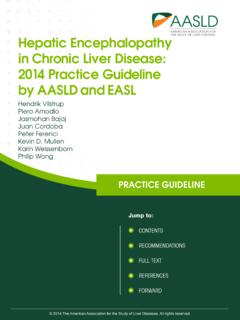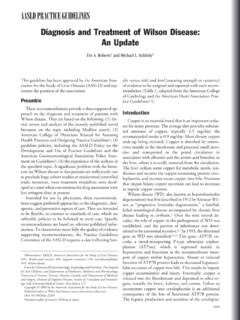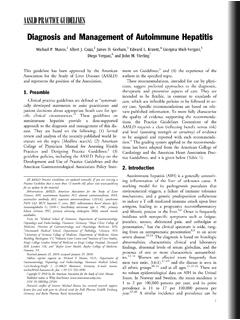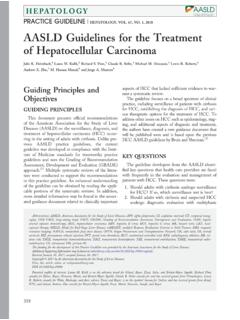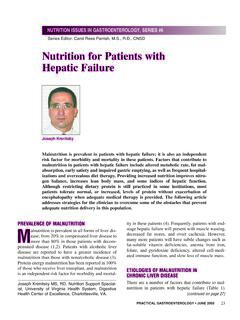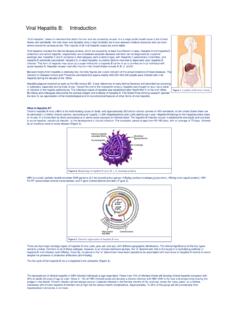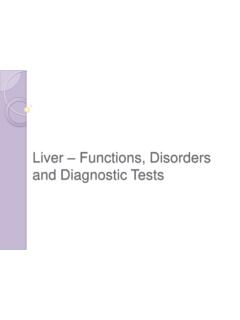Transcription of Hepatic encephalopathy in chronic liver disease: 2014 ...
1 AASLD PRACTICE GUIDELINE. Hepatic encephalopathy in chronic liver disease : 2014 Practice Guideline by the American Association for the Study of liver Diseases and the European Association for the Study of the liver Hendrik Vilstrup,1 Piero Amodio,2 Jasmohan Bajaj,3,4 Juan Cordoba,5 Peter Ferenci,6 Kevin D. Mullen,7. Karin Weissenborn,8 and Philip Wong9. The AASLD/EASL Practice Guideline Subcommittee therapeutic, and preventive aspects of care. They are on Hepatic encephalopathy are: Jayant A. Talwalkar intended to be flexible, in contrast to standards of (Chair, AASLD), Hari S. Conjeevaram, Michael Porayko, care, which are inflexible policies to be followed in Raphael B. Merriman, Peter Jansen, and Fabien every case. Specific recommendations are based on rel- Zoulim. This guideline has been approved by the Ameri- evant published information. can Association for the Study of liver Diseases and the To more fully characterize the available evidence European Association for the Study of the liver and rep- supporting the recommendations, the AASLD/EASL.
2 Resents the position of both associations. Practice Guidelines Subcommittee has adopted the classification used by the Grading of Recommendation Preamble Assessment, Development, and Evaluation (GRADE). workgroup, with minor modifications (Table 1). The These recommendations provide a data-supported classifications and recommendations are based on three approach. They are based on the following: (1) formal categories: the source of evidence in levels I through review and analysis of the recently published world lit- III; the quality of evidence designated by high (A), erature on the topic; (2) guideline policies covered by moderate (B), or low quality (C); and the strength of the American Association for the Study of liver Dis- recommendations classified as strong (1) or weak (2). eases/European Association for the Study of the liver (AASLD/EASL) Policy on the Joint Development and Use of Practice Guidelines; and (3) the experience of Literature Review and Analysis the authors in the specified topic.
3 The literature databases and search strategies are out- Intended for use by physicians, these recommenda- lined below. The resulting literature database was available tions suggest preferred approaches to the diagnostic, to all members of the writing group ( , the authors). Abbreviations: AASLD, American Association for the Study of liver Diseases; ACLF, acute-on- chronic liver failure; ALD, alcoholic liver disease ; ALF, acute liver failure; BCAAs, branced-chain amino acids; CFF, Critical Flicker Frequency; CHE, covert HE; CLD, chronic liver disease ; CRT, Continuous Reaction Time; CT, computed tomography; DM, diabetes mellitus; EASL, European Association for the Study of the liver ; EEG, electroencephalography; GI, gastrointestinal; GRADE, the Grading of Recommendation Assessment, Development, and Evaluation; GCS, Glasgow Coma Scale; GPB, glyceryl phenylbutyrate; HCV, hepatitis C virus;. HE, Hepatic encephalopathy ; HM, Hepatic myelopathy; ICT, Inhibitory Control Test; ISHEN, International Society for Hepatic encephalopathy and Nitrogen Metabolism; IV, intravenous; LOLA, L-ornithine L-aspartate; LT, liver transplantation; MHE, minimal HE; MR, magnetic resonance; OHE, overt HE; PH, por- tal hypertension; PHES, Psychometric Hepatic encephalopathy Score; PP, portal pressure; PSE, portosystemic encephalopathy ; PSS, portosystemic shunting; RCT, randomized, controlled trial; TIPS, transjugular intrahepatic portosystemic shunt; VB, variceal bleeding; WHC, West Haven Criteria; WM, working memory.
4 From the 1 Department of Hepatology and Gastroenterology, Aarhus University Hospital, Aarhus, Denmark; 2 Department of Medicine - DIMED, University of Padova, Padova, Italy; 3 Division of Gastroenterology, Hepatology and Nutrition, Virginia Commonwealth University, Richmond, VA; 4 McGuire Veterans Affairs Medical Center, Richmond, VA; 5 liver Unit, Hospital Vall d'Hebron, Barcelona, Spain; 6 Department of Internal Medicine III (Gastroenterology and Hepatology), Medical University of Vienna, Vienna General Hospital (AKH), Vienna, Austria; 7 Division of Gastroenterology, MetroHealth Medical Center, Case Western Reserve University, Cleveland, OH; 8 Department of Neurology, Hannover Medical School, Hannover, Germany; 9 Division of Gastroenterology and Hepatology, McGill University, Montreal, Quebec, Canada. All AASLD Practice Guidelines are updated annually. If you are viewing a Practice Guideline that is more than 12 months old, please visit for an update in the material.
5 This Practice Guideline is copublished in the Journal of Hepatology. Received April 28, 2014; accepted April 28, 2014.. Deceased. 715. 716 VILSTRUP ET AL. HEPATOLOGY, August 2014. Table 1. GRADE System for Evidence Grade Evidence I Randomized, controlled trials II-1 Controlled trials without randomization II-2 Cohort or case-control analytic studies II-3 Multiple time series, dramatic uncontrolled experiments III Opinions of respected authorities, descriptive epidemiology Evidence Description High quality Further research is very unlikely to change our confidence in the estimated effect. A. Moderate Further research is likely to have an important impact on our confidence in the estimate effect and may change the B. estimate. Low quality Further research is likely to have an important impact on our confidence in the estimate effect and is likely to change C. the estimate. Any change of estimate is uncertain. Recommendation Strong Factors influencing the strength of recommendation included the quality of evidence, presumed patient-important out- 1.
6 Comes, and costs. Weak Variability in preferences and values, or more uncertainty. Recommendation is made with less certainty, higher costs, or 2. resource consumption. They selected references within their field of expertise of liver disease , severely affecting the lives of patients and experience and graded the references according to and their caregivers. Furthermore, cognitive impair- the GRADE The selection of references for the ment associated with cirrhosis results in utilization of guideline was based on a validation of the appropriateness more health care resources in adults than other mani- of the study design for the stated purpose, a relevant festations of liver Progress in the area has number of patients under study, and confidence in the been hindered by the complex pathogenesis that is not participating centers and authors. References on original yet fully elucidated. Apart from such biological factors, data were preferred and those that were found unsatisfac- there remains the larger obstacle that there are no uni- tory in any of these respects were excluded from further versally accepted standards for the definition, diagno- evaluation.
7 There may be limitations in this approach sis, classification, or treatment of HE, mostly as a when recommendations are needed on rare problems or result of insufficient clinical studies and standardized problems on which scant original data are available. In definitions. Clinical management tends to be depend- such cases, it may be necessary to rely on less-qualified ent on local standards and personal views. This is an references with a low grading. As a result of the impor- unfavorable situation for patients and contrasts with tant changes in the treatment of complications of cirrho- the severity of the condition and the high level of sis (renal failure, infections, and variceal bleeding [VB]), standardization in other complications of cirrhosis. studies performed more than 30 years ago have generally The lack of consistency in the nomenclature and gen- not been considered for these guidelines. eral standards renders comparisons among studies and patient populations difficult, introduces bias, and hin- ders progress in clinical research for HE.
8 The latest Introduction attempts to standardize the nomenclature were pub- Hepatic encephalopathy (HE) is a frequent compli- lished in 2002 and suggestions for the design of HE. cation and one of the most debilitating manifestations trials in 2011. Because there is an unmet need for Address reprint requests to: Hendrik Vilstrup, , , Department of Hepatology and Gastroenterology, Aarhus University Hospital, 44 N rrebrogade, DK. 8000 Aarhus C, Denmark. E-mail: fax: 145 7846 2860. Copyright VC 2014 by the American Association for the Study of liver Diseases. View this article online at DOI Potential conflict of interest: Dr. Wong consults, advises, and received grants from Gilead. He consults and advises Roche. He advises and received grants from Vertex. Dr. Ferenci advises Ocera and Salix. Dr. Bajaj consults and received grants from Otsuka and Grifols. He consults for Salix. Dr. Mullen is on the speakers'. bureau for Salix and Abbott.
9 HEPATOLOGY, Vol. 60, No. 2, 2014 VILSTRUP ET AL. 717. recommendations on the clinical management of HE, This definition, in line with previous versions,10,11. the EASL and the AASLD jointly agreed to create is based on the concept that encephalopathies are these practice guidelines. It is beyond the scope of diffuse disturbances of brain function 5 and that the these guidelines to elaborate on the theories of patho- adjective Hepatic implies a causal connection to liver genesis of HE, as well as the management of encephal- insufficiency and/or perihepatic vascular opathy resulting from acute liver failure (ALF), which has been published as guidelines recently. Rather, its Epidemiology aim is to present standardized terminology and recom- mendations to all health care workers who have The incidence and prevalence of HE are related to patients with HE, regardless of their medical disci- the severity of the underlying liver insufficiency and pline, and focus on adult patients with chronic liver In patients with cirrhosis, fully symptomatic disease (CLD), which is, by far, the most frequent overt HE (OHE) is an event that defines the decom- scenario.
10 Pensated phase of the disease , such as VB or As these guidelines on HE were created, the authors Overt Hepatic encephalopathy is also reported in sub- found a limited amount of high-quality evidence to jects without cirrhosis with extensive ,9. extract from the existing literature. There are many rea- The manifestation of HE may not be an obvious sons for this; the elusive character of HE is among clinical finding and there are multiple tools used for them, as well as the lack of generally accepted and uti- its detection, which influences the variation in the lized terms for description and categorization of HE. reported incidence and prevalence rates. This makes a practice guideline all the more necessary The prevalence of OHE at the time of diagnosis of for future improvement of clinical studies and, subse- cirrhosis is 10%-14% in general,16-18 16%-21% in quently, the quality of management of patients with those with decompensated cirrhosis,7,19 and 10%-50%.
